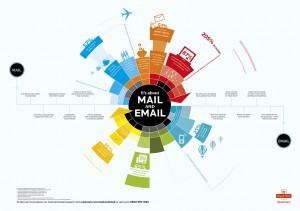 The new Gmail Tabs feature, which rolled out to all users last month, appears to be having a negative impact on email marketing open rates. That’s according to research from MailChimp and is the opposite of what research from Return Path found. However, there is a reason for the discrepancy. Let’s take a closer look.
The new Gmail Tabs feature, which rolled out to all users last month, appears to be having a negative impact on email marketing open rates. That’s according to research from MailChimp and is the opposite of what research from Return Path found. However, there is a reason for the discrepancy. Let’s take a closer look.
The Return Path study looked at email open rates during the week after Gmail Tabs rolled out fully. The MailChimp study looked at email open rates after the first week that Gmail Tabs launched in order to account for “shiny new toy syndrome.” You can follow the preceding link to learn about the Return Path study results. Following are some interesting details about the MailChimp study. Keep in mind, neither study can factor in the adoption rate of Gmail Tabs, so the data is limited in that respect.
MailChimp analyzed every delivery to a Gmail inbox over the past year from its database (12.5 billion emails with more than 2 billion unique opens) to identify open rate trends. Next, the data was narrowed to six weeks around the Gmail Tabs launch, which equated to 1.5 billion emails. Finally, the analysis of open rates was done by Matt Grove of MailChimp as follows:
“Gmail published their blog post about the tabbed inbox on May 29, which was the 22nd week of 2013. The week after that announcement, we actually saw increased open rates. Everyone likes a new toy, and the added attention that changing the inbox brings probably skewed results that week. To compensate, I skewed my concept of the “event” to the week after the attention died down. That’s when I saw a small but definite drop.”
As you can see from Matt’s explanation, his research corroborates the Return Path research, which saw open rates increase after the launch of Gmail tabs. However, a week later, open rates dropped. Matt explained his findings as follows:
“Before the tabbed layout, open rates to Gmail had been above 13% for 15 weeks. They never dipped below that threshold unless there was a specific holiday. The open rates stayed down for three consecutive weeks. From looking at a year and a half’s worth of data, I can say that kind of behavior isn’t normal.”
MailChimp is continuing to monitor how Gmail tabs are affecting open rates. In the meantime, they suggest that convincing the people on your email marketing lists to move your messages to the Primary Tab in Gmail is the best way to get there. The MailChimp team has tried a variety of tactics to get email marketing messages to automatically go to the Primary Tab but they’ve had no luck so far. They also suspect that if promotional email messages do end up in the Primary Tab by bypassing Google’s methods of flagging them as promotional, Google will respond quickly by modifying their methods and ensuring those emails aren’t missed in the future.
Bottom-line, it’s not surprising that Gmail tabs are negatively affecting email open rates for brand marketers. However, brand marketers have to create amazing, relevant, and meaningful content. Be useful and timely with your email marketing messages, and you might just motivate Gmail recipients to move your messages to the primary tab.
Image: Sergio Roberto Bichara
Lucy is Editor at Corporate Eye


